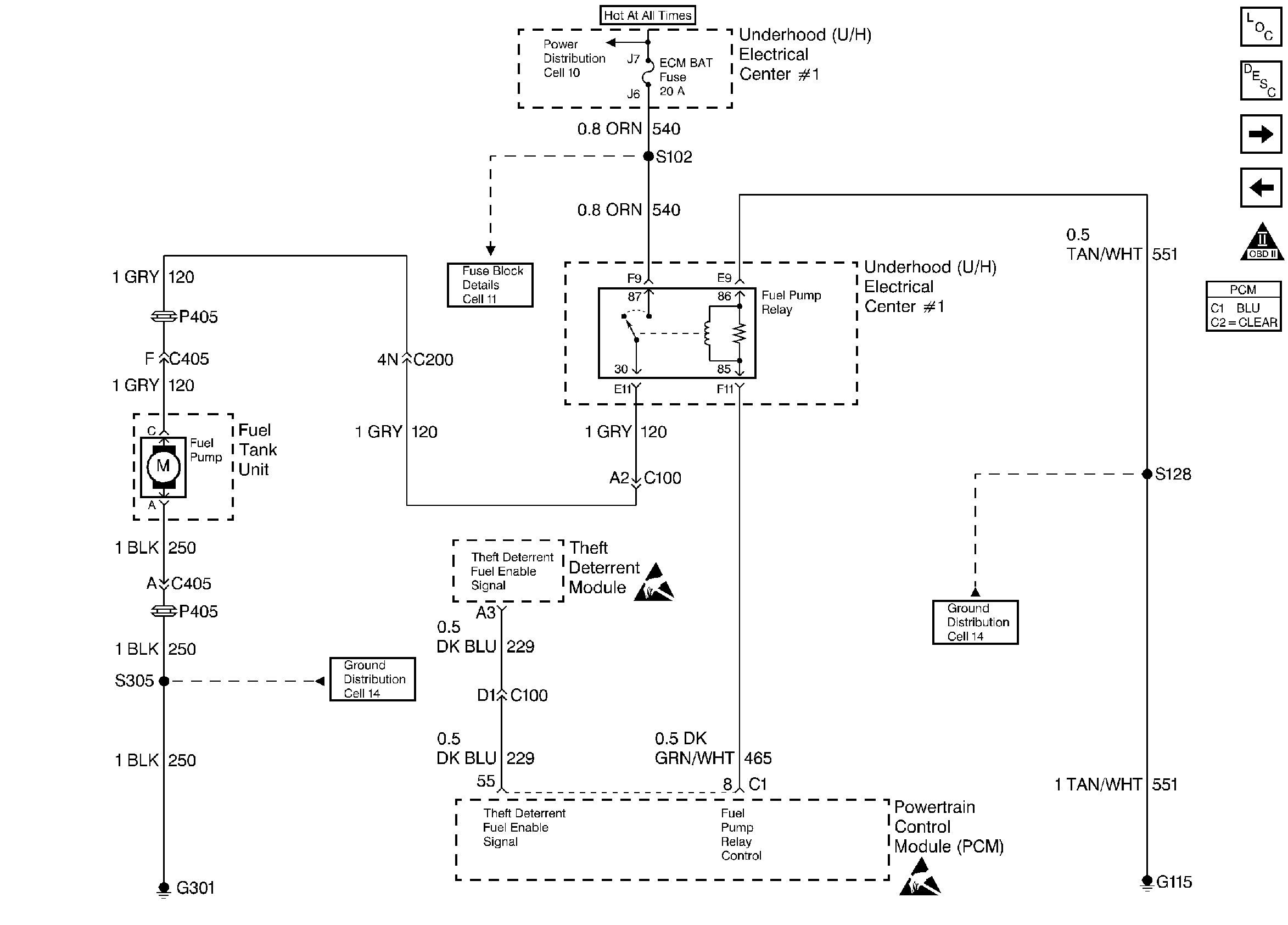Refer to
Fuel Pump Control

.
Circuit Description
When the ignition switch is first turned ON, the PCM energizes the fuel pump relay which applies power to the fuel pump control module. The fuel pump relay will remain ON as long as the engine is running or cranking and the PCM is receiving reference pulses. If no reference pulses are present, the PCM de-energizes the fuel pump relay within 2 seconds after the ignition is turned ON or the engine is stopped. The fuel pump delivers fuel to the fuel rail and injectors, then to the fuel pressure regulator. The fuel pressure regulator controls fuel pressure by allowing excess fuel to be returned to the fuel tank. With the engine stopped, the fuel pump can be turned ON by using the scan tool output controls function.
The PCM alters fuel pump speed by varying the duty cycle on the fuel pump speed control PWM circuit to the fuel pump control module. Under normal conditions, the fuel pump speed control PWM circuit duty cycle is set at 33%. When higher fuel volume is required due to increased engine load (MAP sensor value over 90 kPa), the PCM switches the fuel pump speed control PWM circuit duty cycle to 100%. At a the higher duty cycle, the fuel pump control module increases the voltage the in-tank fuel pump, allowing a higher volume of fuel to be delivered to the fuel rail. The PCM also compensates for low system voltage by switching the fuel pump control circuit PWM duty cycle to 100%.
Diagnostic Aids
An intermittent may be caused by a poor connection, rubbed through wire insulation or a wire broken inside the insulation. Check for the following items:
| • | Poor connection or damaged harness. |
| • | Inspect the PCM harness and connectors for improper mating, broken locks, improperly formed or damaged terminals, poor terminal to wire connection, and damaged harness. |
Test Description
Number(s) below refer to the Step number(s) on the Diagnostic Table:
-
Verifies that the fuel pump feed circuit is OK between the fuel pump relay and the fuel pump, and that the fuel pump can deliver adequate pressure to the fuel rail.
-
Checks the ignition feed circuit to the fuel pump relay.
-
Ensures that the fuel pump relay driver circuit and the PCM are capable of controlling the fuel pump relay.
-
Checks the fuel pump driver circuit for a short to ground.
-
Checks the fuel pump driver circuit for an open.
-
If the fuel pump is operating but incorrect pressure is noted, the fuel pump wiring is OK and the Fuel System Pressure Test should be used for diagnosis.
-
Checks the fuel pump feed circuit between the fuel pump relay and the fuel pump. Also checks the fuel pump ground circuit.
-
Determines whether the problem is being caused by an open in the fuel pump feed circuit or the fuel pump ground circuit.
-
This vehicle is equipped with a PCM which utilizes an Electrically Erasable Programmable Read Only Memory (EEPROM). When the PCM is being replaced, the new PCM must be programmed.
Step | Action | Value(s) | Yes | No |
|---|---|---|---|---|
1 | Was the Powertrain On-Board Diagnostic (OBD) System Check performed? | -- | ||
Is fuel pressure indicated at the specified value? | 333-376 kPa (48-55 psi) | |||
Is the test light ON? | -- | |||
Did the test light turn ON for approximately 2 seconds? | -- | |||
Is the test light ON? | -- | |||
Was a problem found? | -- | |||
7 |
Was a problem found? | -- | ||
8 |
Was a problem found? | -- | ||
9 | Probe the ignition feed circuit at the fuel pump relay connector with a test light to ground. Is the test light ON? | -- | ||
Remove the fuel filler cap and listen for the fuel pump running. Is the fuel pump running? | -- | |||
Is the test light ON? | -- | |||
Probe the fuel pump feed circuit at the modular fuel sender harness connector with a test light to chassis ground. Is the test light ON? | -- | |||
13 | Locate and repair open in the fuel pump feed circuit. Refer to Repair procedures in Electrical Diagnosis. Is action complete? | -- | -- | |
14 | Locate and repair open in the fuel pump ground circuit. Refer to Repair procedures in Electrical Diagnosis. Is action complete? | -- | -- | |
15 | Locate and repair short to ground in the fuel pump relay driver circuit. Refer to Repair procedures in Electrical Diagnosis. Is action complete? | -- | -- | |
16 | Locate and repair open in ignition feed to the fuel pump relay. Refer to Repair procedures in Electrical Diagnosis. Is action complete? | -- | -- | |
17 | Locate and repair open in ground circuit to the fuel pump relay. Refer to Repair procedures in Electrical Diagnosis. Is action complete? | -- | -- | |
18 | Replace the fuel pump relay. Is action complete? | -- | -- | |
19 | Replace the fuel pump. Go to Fuel Sender Assembly Service . Is action complete? | -- | -- | |
Replace the PCM Important: : Replacement PCM must be programmed. Go to Powertrain Control Module Replacement/Programming . Is action complete? | -- | -- | ||
21 |
Is fuel pressure indicated at the specified value? | 333-376 kPa (48-55 psi) | System OK |
